Adaptive Response Surface Methods ARSM for Design Optimization - PowerPoint PPT Presentation
1 / 31
Title:
Adaptive Response Surface Methods ARSM for Design Optimization
Description:
Response Surface Models ... ARSM with Inherited Latin Hypercube Design Points ... Numerical models are 'black-boxes' to the design integrator no API coding ... – PowerPoint PPT presentation
Number of Views:298
Avg rating:3.0/5.0
Title: Adaptive Response Surface Methods ARSM for Design Optimization
1
Adaptive Response Surface Methods (ARSM) for
Design Optimization
CAD CG National Research Center Zhejiang
University August 19, 2002
- Gary Wang, Assistant Prof.
- U. of Manitoba, Canada
2
Computation-intensive Design Problems
- At least one function requires a
computation-intensive analysis for function
evaluation this function can be either the
objective function or a constraint function. - The gradient information or any other properties
of the computation-intensive function is not
available, or computing those properties is too
costly or unreliable - A goal is to minimize the total number of
computation-intensive function evaluations and
maximizing the amount of parallel computation. - The simulations and analyses are deterministic
3
An Example
Each simulation takes 36-160 hrs for Ford Motor
Inc.
4
Westland Helicopters
5
Virtual Prototyping-based Design
6
Design for Mafg./Production
7
The Challenge
- Design with computation-intensive processes
- Global optimum with constraints?
- Balance
Global Optimum
Compu-tation cost
8
Outline
- Review of the Response Surface Method (RSM)
- Essence of the Adaptive Response Surface Method
(ARSM) - ARSM Inherited Samples
- Fuzzy clustering based space reduction method
9
Conventional Optimization
- Problems
- Sequential
- Time (Iteration)x(160 hrs, e.g.)
- Only one optimum, which may not be acceptable
- What if the process got stuck?
10
Response Surface Method
- RSM, metamodeling, approximation-based design,
etc. - RS metamodel, surrogate
- Idea
- Treat f(x) unknown when given an input x0, it
gives an output f(x0) - Sampling regression ? Optimization
11
Response Surface Models
- A response surface model derives its name from
being a model of a response that looks like a
surface in 2-D - General form of a response surface
- where
- f(x) can be linear, linearinteractions, or a
full second-order polynomial function of x - bi are parameters used to fit the model using
least squares regression bi (XX)-1XY
12
Response Surface Method
- Benefits
- Parallel computation
- Quick, cheap (1160 hr)
- No software integration, easy coding
- Identify relative importance of parameters (i.e.,
gain knowledge of the surface)
13
Response Surface Method
What are the problems?
14
Approaches in Literature
- Sampling, e.g. DOE, D-optimality, Latin
Hypercube, OA, Hammersley - Approximation Models, e.g., Polynomial, Kriging,
RBF, ANN, MARS, - Design Space Reduction
- Dimensionality
- Size
15
Our Previous Work
- Adaptive Response Surface Method (ARSM)
- (Engineering Optimization, Vol. 33, No. 6, 2001,
pp. 707-734) - ARSM with Inherited Latin Hypercube Design Points
- (Journal of Mechanical Design, Transactions of
the ASME, in print)
16
Overview of the ARSM
- Assume f is unknown
- Gradually reduce the search space
- The minimum of the second fitted function is
close to the real optimum at about x2.13
17
Algorithm of the ARSM
18
Identification of the Reduced Space
19
Identification of the Reduced Design Space
20
Difficulties of the ARSM
- Central Composite Designs (CCD) 2n 2n 1
- A new set of CCDs in a new design space
- Inherit the optimum from the last iteration?
21
Central Composite Design (CCD) vs. Latin
Hypercube Design (LHD)
CCD for n2 M2n 2n 1
LHD for n2 M arbitrary
22
Latin Hypercube Designs
- Space filling property ideal for computer
experiments - Uniform random sampling
- Number of points controllable (n1)(n2)/2
- Potential point inheritance
23
LHD Inheritance
24
LHD Inheritance
25
Review of the Difficulties of the Previous ARSM
- Central Composite Designs (CCD) 2n 2n 1
- A new set of CCDs in a new design space
- Inherit the optimum from the last iteration?
26
Test Problems
- Goldstein and Price function (GP), n 2.
- Six-hump camel-back function (SC), n 2.
- Branin function (BR), n 2.
- Generalized polynomial function (GF), n 2.
- Rastrigin function (RS), n 2.
- Geometric container function (Constrained) (GC),
n 3. - Hartman function (HN), n 6.
27
Test of ARSM
Goldstein and Price Function
Goldstein and Price Function
28
Test Results
29
Design Results
30
Advantages of the ARSM
- Numerical models are black-boxes to the design
integrator no API coding - A design can be simultaneously analyzed from
various perspectives with different models,
either commercial or home-developed models
shorter analysis time - The significance of each design variable and
their interrelationship is obvious engineering
insight - The total number of function evaluations
(numerical analyses) is minimum low cost and
quick optimization - Global design optimum can be obtained better
product quality
31
Summary
- RSM is suitable for computation-intensive
problems - ARSM is a better approach than RSM in terms of
efficiency and accuracy - LHD is better than CCD for the ARSM
- A lot more interesting issues to be solved































